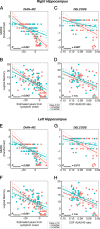The BDNFVal66Met SNP modulates the association between beta-amyloid and hippocampal disconnection in Alzheimer's disease
- PMID: 30899092
- PMCID: PMC6754794
- DOI: 10.1038/s41380-019-0404-6
The BDNFVal66Met SNP modulates the association between beta-amyloid and hippocampal disconnection in Alzheimer's disease
Abstract
In Alzheimer's disease (AD), a single-nucleotide polymorphism in the gene encoding brain-derived neurotrophic factor (BDNFVal66Met) is associated with worse impact of primary AD pathology (beta-amyloid, Aβ) on neurodegeneration and cognitive decline, rendering BDNFVal66Met an important modulating factor of cognitive impairment in AD. However, the effect of BDNFVal66Met on functional networks that may underlie cognitive impairment in AD is poorly understood. Using a cross-validation approach, we first explored in subjects with autosomal dominant AD (ADAD) from the Dominantly Inherited Alzheimer Network (DIAN) the effect of BDNFVal66Met on resting-state fMRI assessed functional networks. In seed-based connectivity analysis of six major large-scale networks, we found a stronger decrease of hippocampus (seed) to medial-frontal connectivity in the BDNFVal66Met carriers compared to BDNFVal homozogytes. BDNFVal66Met was not associated with connectivity in any other networks. Next, we tested whether the finding of more pronounced decrease in hippocampal-medial-frontal connectivity in BDNFVal66Met could be also found in elderly subjects with sporadically occurring Aβ, including a group with subjective cognitive decline (N = 149, FACEHBI study) and a group ranging from preclinical to AD dementia (N = 114, DELCODE study). In both of these independently recruited groups, BDNFVal66Met was associated with a stronger effect of more abnormal Aβ-levels (assessed by biofluid-assay or amyloid-PET) on hippocampal-medial-frontal connectivity decreases, controlled for hippocampus volume and other confounds. Lower hippocampal-medial-frontal connectivity was associated with lower global cognitive performance in the DIAN and DELCODE studies. Together these results suggest that BDNFVal66Met is selectively associated with a higher vulnerability of hippocampus-frontal connectivity to primary AD pathology, resulting in greater AD-related cognitive impairment.
Conflict of interest statement
A.M.F. has received research funding from Biogen, Fujirebio, and Roche Diagnostics. She is a member of the scientific advisory boards for Roche, Genentech, and AbbVie and also consults for Araclon/Griffols and DiamiR.: Y.Y.L. has served as a scientific consultant to Biogen and Lundbeck; M.B. who has consulted or advisory board for Araclon, Grifols, Lilly, Nutricia, Roche and Servier. She received fees for lectures and funds for research from Araclon, Grifols, Nutricia, Roche and Servier. She has not received personal compensations from these organizations. A. Ruiz has consulted for Grifols and Landsteiner Genmed. He received funds for research and/or reimbursement of expenses for congresses attendance from Araclon, and Grifols. He has not received personal compensations from these organizations: T.B., Investigator, initiated research funding sponsored by Avid Radiopharmaceuticals (a wholly owned subsidiary of Eli Lilly) and Foundation for the NIH. Clinical trials sponsored by Avid Radiopharmaceuticals, Eli Lilly, Roche, Jaansen, Biogen, and NIH. Travel sponsored by the American Society for Neuroradiology, Alzheimer’s Association International Convention, NIH. The remaining authors declare that they have no conflict of interest.
Figures



References
-
- Hall J, Thomas KL, Everitt BJ. Rapid and selective induction of BDNF expression in the hippocampus during contextual learning. Nat Neurosci. 2000;3:533–5. - PubMed
-
- Murer MG, Yan Q, Raisman-Vozari R. Brain-derived neurotrophic factor in the control human brain, and in Alzheimer's disease and Parkinson's disease. Prog Neurobiol. 2001;63:71–124. - PubMed
-
- Lu B, Nagappan G, Lu Y. BDNF and synaptic plasticity, cognitive function, and dysfunction. Handb Exp Pharmacol. 2014;220:223–50. - PubMed
Publication types
MeSH terms
Substances
Grants and funding
- U24 AG021886/AG/NIA NIH HHS/United States
- R01 AG058676/AG/NIA NIH HHS/United States
- K01 AG053474/AG/NIA NIH HHS/United States
- P01 AG026276/AG/NIA NIH HHS/United States
- MR/009076/1/MRC_/Medical Research Council/United Kingdom
- MR/L023784/1/MRC_/Medical Research Council/United Kingdom
- P30 NS048056/NS/NINDS NIH HHS/United States
- UF1 AG032438/AG/NIA NIH HHS/United States
- K23 AG049087/AG/NIA NIH HHS/United States
- MR/L023784/2/MRC_/Medical Research Council/United Kingdom
- UL1 TR002345/TR/NCATS NIH HHS/United States
- U19 AG032438/AG/NIA NIH HHS/United States
- R01 EB009352/EB/NIBIB NIH HHS/United States
- P30 NS098577/NS/NINDS NIH HHS/United States
LinkOut - more resources
Full Text Sources
Medical

